written and photographed by Chuck Giles
Mar 2004, Vol. 8 No. 5
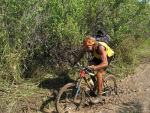 I must have been on the edge. Why else would I be riding a bike in Egypt? The truth of the matter is that months earlier I had read a small notice in a cycling magazine advertising the Tour d’Afrique. My interest was piqued, and after checking out their website, I wanted to accept this challenge. Tour d’Afrique was a 120-day bike race beginning in Cairo, Egypt and ending in Cape Town, South Africa. The distance, covering the entire length of Africa, was 11,000 km. or 6,900 miles. 20 rest days were including during the grueling four-month traverse of the continent.
I must have been on the edge. Why else would I be riding a bike in Egypt? The truth of the matter is that months earlier I had read a small notice in a cycling magazine advertising the Tour d’Afrique. My interest was piqued, and after checking out their website, I wanted to accept this challenge. Tour d’Afrique was a 120-day bike race beginning in Cairo, Egypt and ending in Cape Town, South Africa. The distance, covering the entire length of Africa, was 11,000 km. or 6,900 miles. 20 rest days were including during the grueling four-month traverse of the continent.
And traverse Africa was an understatement. In mid-January, 32 of us mounted our bikes in the shadow of the Sphinx heading east toward the Red Sea. Our journey would passed through 10 countries: Egypt, Sudan, Ethiopia, Kenya, Tanzania, Malawi, Mozambique, Zimbabwe, Botswana and South Africa.
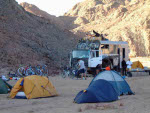 Other than my accident, we were off to a good start. But, only in Egypt would we ride roads with a bike lane. That lane didn’t protect me from the car collision on the second day of the ride. My wife, back in the United States, fed-exed a new wheel which arrived in a few days. I was back on the bike pedaling, but my body still ached and the shoulder never completely recovered.
Other than my accident, we were off to a good start. But, only in Egypt would we ride roads with a bike lane. That lane didn’t protect me from the car collision on the second day of the ride. My wife, back in the United States, fed-exed a new wheel which arrived in a few days. I was back on the bike pedaling, but my body still ached and the shoulder never completely recovered.
Until the tire arrived, I was bikeless so I used the recovery time by riding in the truck. This limited the actual distance of my Africa ride to only 5,000 miles. My determination to finish the race was not diminished by having to spend time in the overland trucks that accompanied the group. It proved an interesting alternative, a great lookout point for viewing the route. With no need to focus on the road, it was possible to see the animals nearby and absorb some of the incredible countryside we passed.
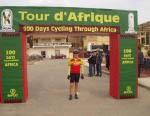 Thirty-two men and woman (at 62, I claimed the eldest award) began the challenging adventure in Cairo. The ride was completed by thirty riders. Of the two who quit, one fell in the Sudan, breaking his elbow, which forced him to return home for surgery. The only other American had had enough camp food, squatty potties and bush camp living by the time he arrived in Nairobi. He bagged the trip there.
Thirty-two men and woman (at 62, I claimed the eldest award) began the challenging adventure in Cairo. The ride was completed by thirty riders. Of the two who quit, one fell in the Sudan, breaking his elbow, which forced him to return home for surgery. The only other American had had enough camp food, squatty potties and bush camp living by the time he arrived in Nairobi. He bagged the trip there.
The Red Sea, contrary to its name, is very blue. Heading south the Gulf of Suez is only a few miles wide separating Egypt from the Sinai and Arabian Peninsula. Although we were separated from Iraq by the country of Jordan, at that time, we felt no sense of imminent danger created by the pre-war sparring going on between Saddam Hussein and President George W. Bush.
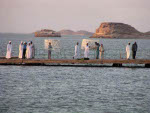 Following a terrorist incident with German tourists several years ago, Egypt, a country that relies heavily on tourism, adopted a very protective attitude toward tourists. We were grateful to be escorted by soldiers along our route in Egypt, but they also made our lives more difficult. During nights spent in bush camps, the soldiers yelled when they communicated during the night. We were unsuccessful in persuading them to “knock it off” so we could sleep.
Following a terrorist incident with German tourists several years ago, Egypt, a country that relies heavily on tourism, adopted a very protective attitude toward tourists. We were grateful to be escorted by soldiers along our route in Egypt, but they also made our lives more difficult. During nights spent in bush camps, the soldiers yelled when they communicated during the night. We were unsuccessful in persuading them to “knock it off” so we could sleep.
Heading westward, we bicycled along the Nile to Luxor. Ancient temples and tombs of the Pharaohs are ornately designed with hieroglyphics and paintings. We were fortunate to have a rest day in Luxor so we could take in the antiquities, pyramids that loom more impressively than those in Cairo. It is apparent that many of the high powered Pharaohs ruled here.
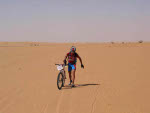 Tour d’Afrique was granted rare permission to bicycle from Aswan, the site of the High Dam, to Abu Simbel, the site of a spectacular Pharaoh tombs. When the High Dam was built, the tomb was moved to higher ground to avoid being engulfed by the rising lake. This remarkable project took almost four years to complete. Leaving Egypt, we loaded our bikes on a ferry to motor across Lake Nasser to Wadi Halfa, our port of entry into the Sudan.
Tour d’Afrique was granted rare permission to bicycle from Aswan, the site of the High Dam, to Abu Simbel, the site of a spectacular Pharaoh tombs. When the High Dam was built, the tomb was moved to higher ground to avoid being engulfed by the rising lake. This remarkable project took almost four years to complete. Leaving Egypt, we loaded our bikes on a ferry to motor across Lake Nasser to Wadi Halfa, our port of entry into the Sudan.
Throughout most of its almost 40 years of independence, Sudan has had an ongoing civil war. The war is being fought in the south, so to avoid conflict, we traveled from the north to the eastern border. During his presidency, Clinton ordered a building bombed near Khartoum, a site of one of Osama bin Laden’s operatives, few visitors have been permitted to enter the Sudan. Our group was most likely granted visas for propaganda value. We were paraded through villages and thousands of people gathered in a town square in Khartoum to cheer our arrival into the city. Their welcome made us feel great after the strenuous ride.
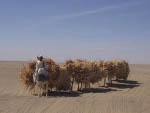 The Sudan government may be suspect, but we found the people friendly and gracious. As for the roads, they were more like tracks. Fanning through the desert in all directions, it appeared as though drivers had attempted to avoid terrain that wasn’t washboard or heavy with sand. We did a great deal of walking our bikes through the Sudan. It was a miracle that no one was permanently lost. Wandering more than ¼-mile away from the Nile River, you’d find yourself in the arid Nubian desert, a place where daytime temperatures often exceeded 120F.
The Sudan government may be suspect, but we found the people friendly and gracious. As for the roads, they were more like tracks. Fanning through the desert in all directions, it appeared as though drivers had attempted to avoid terrain that wasn’t washboard or heavy with sand. We did a great deal of walking our bikes through the Sudan. It was a miracle that no one was permanently lost. Wandering more than ¼-mile away from the Nile River, you’d find yourself in the arid Nubian desert, a place where daytime temperatures often exceeded 120F.
Sudan is primarily Muslim and even the smallest village is built around a mosque. The powerful amplification system of the morning’s first call to prayer begins around 5 a.m. Not a great wake up call for weary riders needing sleep.
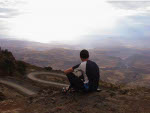 Our destination in the Sudan was the city of Khartoum. Our route took us pass small villages with open-air markets. We took advantage of the markets by stopping to buy fruit and cookies. Sudan is definitely Pepsi country. From the Sudan through Mozambique to South Africa, I drank more soft drinks daily than I ordinarily drink in a year at home.
Our destination in the Sudan was the city of Khartoum. Our route took us pass small villages with open-air markets. We took advantage of the markets by stopping to buy fruit and cookies. Sudan is definitely Pepsi country. From the Sudan through Mozambique to South Africa, I drank more soft drinks daily than I ordinarily drink in a year at home.
In the country of Malawi, we stopped at Senda Bay on beautiful Lake Malawi. Our campground was located next to the La Meriden Hotel at Senda Bay. It was lovely with thick grass, a sandy beach, great scenery, a magnificent lake and a couple of baboons to entertain us–the perfect place to camp for two nights and enjoy a rest day.
 After pitching our tents, a couple riders had the urge to get off the ground and sleep on a hotel bed. Unfortunately the hotel was full, but when they had a no-show later in the day, a Scot named Michael Kennedy quickly took the room. Hurriedly, he left his tent pitched to collapse on the bed in the hotel. In his rush, he left most of his gear in the entrance of the tent. The next morning, he discovered a large, voracious colony of red ants in his tent. He was painfully bitten trying to retrieve his tent. Those ants even colonized his cycling shoes. We had a good laugh at Mike’s expense until we apprehensively checked our own tents. Peter, a young British rider, found so many ants in his tent that he submerged it in the lake fully assembled.
After pitching our tents, a couple riders had the urge to get off the ground and sleep on a hotel bed. Unfortunately the hotel was full, but when they had a no-show later in the day, a Scot named Michael Kennedy quickly took the room. Hurriedly, he left his tent pitched to collapse on the bed in the hotel. In his rush, he left most of his gear in the entrance of the tent. The next morning, he discovered a large, voracious colony of red ants in his tent. He was painfully bitten trying to retrieve his tent. Those ants even colonized his cycling shoes. We had a good laugh at Mike’s expense until we apprehensively checked our own tents. Peter, a young British rider, found so many ants in his tent that he submerged it in the lake fully assembled.
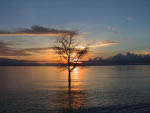 My Kelty V2 tent had survived heavy winds in Egypt and Sudan, 14 days of rain(some torrential) in Tanzania, and daily crew manhandling. The tent was comfy and easy to pitch. The ants did more that just crawl into my tent, they ate holes in it making it look like Kelty V2 Swiss cheese. Repairing it with half roll of duct tape made it serviceable, but one day of heavy rain would probably have flooded it.
My Kelty V2 tent had survived heavy winds in Egypt and Sudan, 14 days of rain(some torrential) in Tanzania, and daily crew manhandling. The tent was comfy and easy to pitch. The ants did more that just crawl into my tent, they ate holes in it making it look like Kelty V2 Swiss cheese. Repairing it with half roll of duct tape made it serviceable, but one day of heavy rain would probably have flooded it.
The Sudan was a land of stark desert, while Ethiopia was lushly vegetated. North of Addis Ababa, the terrain was mountainous. We descended from elevations above 10,000 feet down to 4500. Paved roads were nonexistent and varied between soft or hard pack imbedded with rock. Loose rock and gravel made riding feel like we were spinning on ball bearings. Uphills were difficult, downhills downright dangerous. Anyone who rolled without braking bit the dust. The tighter we gripped our brakes, the more we bounced. These treacherous conditions caused one rider, who clenched his teeth as he bounced violently, to lose three teeth while the constant jarring caused another rider to loose feeling in his hands. Everyone developed saddle sores and a strong lust to get back to riding on pavement.
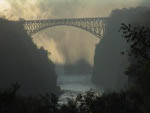 The landscape of Ethiopia is beautiful especially the spectacular Blue Nile Gorge. The churches of Lalibela, built centuries ago, defy description. We saw very few adults and many of the children were insufferable. They were constantly in our faces, demanding money and blocking our path. And those were the well-behaved kids! Some threw rocks, used whips, jammed sticks through bike spokes, and tried to pull riders off their bikes. Riding through Ethiopia would have been impossible without armed guards.
The landscape of Ethiopia is beautiful especially the spectacular Blue Nile Gorge. The churches of Lalibela, built centuries ago, defy description. We saw very few adults and many of the children were insufferable. They were constantly in our faces, demanding money and blocking our path. And those were the well-behaved kids! Some threw rocks, used whips, jammed sticks through bike spokes, and tried to pull riders off their bikes. Riding through Ethiopia would have been impossible without armed guards.
By the time we left Ethiopia, the race had become a riding tour with the exception of two riders. The leader, Sascha Hartl from Austria followed Dave Genders from Great Britain maintained a 3-hour lead. When riding on pavement, the second rider was faster, but the leader was tenacious and always stayed close. Nine riders managed to ride the whole event, overcoming significant obstacles. At the end they were known as the EFI Group: Every F____ Inch.
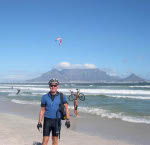 I don’t recommend the event as a diet, but all of us (except one woman)lost weight. We ate porridge every day. I promise it will never pass my lips again. It never occurred to me that Orange Fanta would become a treat, but I began to crave it.
I don’t recommend the event as a diet, but all of us (except one woman)lost weight. We ate porridge every day. I promise it will never pass my lips again. It never occurred to me that Orange Fanta would become a treat, but I began to crave it.
Drivers were rarely courteous and often a hazard. In Zimbabwe, a driver overtook two riders at a high speed. As he started to pass them, he saw on oncoming vehicle. When he pulled back, he rear-ended the riders causing a serious accident.
Americans are probably more accustomed to creature comforts. As we neared Kenya, I got the urge to take a break from riding, eat some good food, and sleep on a real bed. As we made our way to Northern Kenya, the roads and camping conditions were miserable. The roads were rutted, rocky, sandy and covered with thorns. Even the best of the riders struggled. The campsites were as bad as the road conditions.
We were now almost at the halfway point of the ride and the jarring on the road made dealing with my shoulder injury had become almost impossible. It was difficult to ride more than two or three hours a day. I had lost at least twenty-five pounds, and we had not seen a real sit down toilet for close to a month.
In Marsabit, Kenya, I learned that our Kenya travel agent and one other rider, Jonathan, were looking for a ride to Nairobi. How tempting, a little rest and a lot of food sounded extremely good. I joined them in their search.
My decision to temporarily leave the tour was reinforced after checking into the Jay-Jay Hotel. The hotel was infested with enough mosquitoes to lift a small elephant, bed bugs, and squatty potties. Our food order from the restaurant took two hours to arrive. I was ready for a break.
Nigel, the ride’s Kenya travel agent, negotiated a fare for us to ride in a truck cab for sixteen dollars per person. We would leave Marsabit at 6:00am the next morning in a goat truck (they had more room than we did)for the sixteen hour ride to Nairobi. When the vehicle arrived transporting forty goats, there were already three men in the front cab.
My friend John and I climbed into the small sleeper compartment behind the front seat designed to barely hold one person. We set a world record for the number of uncomfortable contorted positions we experienced. The rocky, rutted road reduced our speed to fifteen or twenty miles as we bounced continuously. As bad as the truck was (it broke down twice and was repaired by the driver and helper), it still seemed better than riding the bike.
When the truck left the main road to pick up more goats (on their way to slaughter), we were stopped at least four times by “police officers” who insisted upon the driver giving them a few shillings before the barrier was lifted. One of them took great delight in checking the passports of the two non-African bicycle riders.
In the Samburu part of Kenya many of the villagers still dress traditionally in bright red wraparound clothing. Women covered their upper bodies with long strands of beads. Most of the younger men carried spears.
Back on the main road to Nairobi, the trip was relatively uneventful until we reached Nanyuki, the turn off to Mount Kenya. The famous peak is a spectacular mountain, the second highest in Africa, and its appearance is far more rugged than Kilimanjaro. During WWII, some Italian prisoners were interred at a prison camp near Nanyuki. Three of the prisoners developed an obsession to climb to the top of Mount Kenya and ultimately escaped from their prison camp, successfully reaching their goal.
A short time after Nanyuki, Nigel’s driver and his vehicle, who left from Nairobi, met up with us. Hopping into their car made the remaining two hours of the trip relatively comfortable. Finally we arrived in the bustling city of Nairobi. East African hotels serve exceptional breakfast, and our buffet at the Landmark Hotel was delicious. Jonathan and I ate from the time they opened until they threw us out.
When we were asked to leave, we discovered of a shopping center across the street from the hotel. It had email, a Wimpy’s, and a fully stocked super market selling Snickers bars. Life was bearable again. The “R&R” passed quickly as I rejoined the tour four days later as it passed through Nairobi.
Riding through South Africa was a pleasure. We knew the end was near, campsites were nice, and the veldt provided decent roads with little traffic. The finish line was at Table Mountain View, Cape Town is an impressive city of about four and a half million.
The Tour d’Afrique ride across the continent of Africa ended with little fanfare, other than our own celebration. The completion of the four-month ride felt wonderful to our tired bodies. The ride organizers poured champagne and as we sipped it, a nearby penguin colony appeared to be applauding us. Scenic Table Mountain was a great final destination for a remarkable journey.
Am I glad I did it? Yes. Would I do it again? No, absolutely not, well, hum, I don’t think so.
If you go: http://tourdafrique.com
